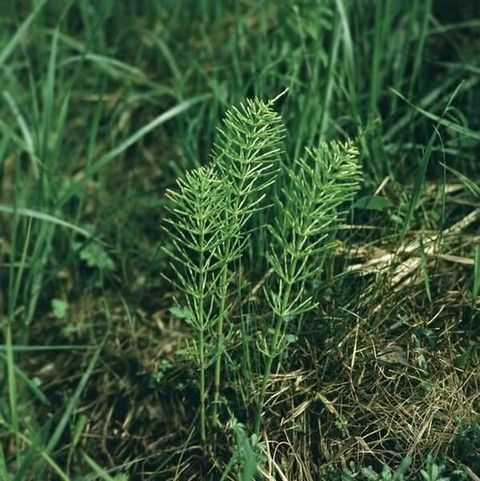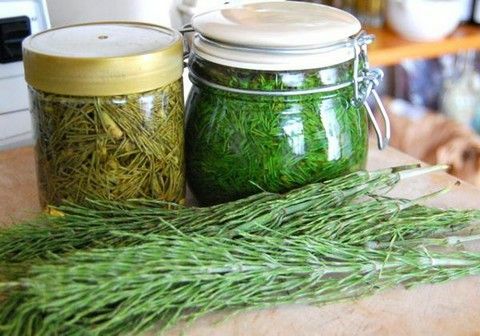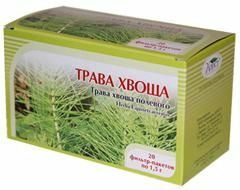- Useful qualities of horsetail
- Application of horsetail: recommended recipes
- Categorical contraindications to the use of horsetail
 The horsetail field in folk medicine has been used for a long time, but in prescription reference books one can often find its mutated names. For example, a field pine, an ephedra, a marsh column, a marsh fir grove, a grass-tin and a yawnee. It is a perennial herb, belongs to the family of horsetail and multiplies by spores. The root grows horizontally, and from it grows a lot of reddish-brown unbranched stems. At the end of each stem is an ear with spores.
The horsetail field in folk medicine has been used for a long time, but in prescription reference books one can often find its mutated names. For example, a field pine, an ephedra, a marsh column, a marsh fir grove, a grass-tin and a yawnee. It is a perennial herb, belongs to the family of horsetail and multiplies by spores. The root grows horizontally, and from it grows a lot of reddish-brown unbranched stems. At the end of each stem is an ear with spores.
After each new branch of the spore-spike die and the next place on this stem grows a new, green parish. The plant reaches fifty centimeters in height and is strongly branched from the root.
This medicinal plant grows on wet land and swampy areas. For example, in river floodplains, on their shores, around lakes and ponds, on clay and sandy soil. Where other herbs can not grow due to soil poverty, the horsetail feels great and grows in large areas. There are also a lot of horsetails on acidic soils.
Useful qualities of horsetail
Roots and stems of marsh-tailed horsetail possess certain medicinal qualities. In traditional medicine, this raw material is used to treat inflammation in the bladder, pleurisy, edema, insufficient blood supply, and also as a means with a diuretic and hemostatic effect.
Traditional medicine offers treatment of horsetail from rheumatism, atherosclerosis, heart failure, gout, hepatic colic, pulmonary tuberculosis, bronchitis, bladder stones, hypertension, pulmonary hemorrhage. Horsetail meadow treats infected wounds, boils, lichen, allergic skin lesions. In dentistry, the plant is used to rinse the oral cavity, as treatment of inflammation of the mucous membranes.
In a season of catarrhal diseases, a decoction can rinse the nose and bathe the children in it, adding a few glasses of broth to the water for taking baths.
Important: it is worthwhile to carefully observe the recommended dosage, because otherwise horsetail preparations can provoke gastric disorders and diarrhea.
Young shoots and rhizomes of horsetail forest contain a lot of starchy substances, vitamins A and C, so the green parts of the plant can be included in the diet in green, adding them as seasoning to meat or as greens for salads.
Procurement of raw materials
To use the horsetail of the field, it is beneficial - it must be properly harvested. For this purpose, only green overground parts are collected, which are called vegetative shoots. They are cut from the beginning of June to the end of July, using a sharp knife for this. Drying should take place outdoors, in shading. Raw materials spread a thin layer on waxed paper. To store dried horsetail can be no more than four years.
Since there are several different species of this plant in nature, it is advisable to carefully consider the photo of the horsetail before the start of the harvest. Because this is the kind of homeopath recommended to use as a raw material for home treatment.
Means from horsetail help to remove lead from the body, various toxic substances, improve salt metabolism. In old age people are advised to use diluted horsetail infusions, this will be a good prevention of atherosclerosis. Therapeutic course - two weeks.

Application of the horsetail: recommended recipes
The infusion is prepared easily: take four dessert spoons of dry minced raw material and pour half a liter of boiling water. The mixture is insisted for twenty minutes, after which it is filtered and used inward. The whole volume must be drunk within two days, which means that the allowable dosage is three full spoons 4 times a day.
Important: the infusion of horsetail is strictly forbidden to people with kidney disease.
Horsetail herb is used as a remedy for inflammation and diuretic, as it can reduce pain in the bladder, by extracting urine and reducing the protein volume in it. With its help, the ureters are cleaned of toxins. Decoction of the grass is prepared as follows: take dry shredded raw materials, pour it with warm water in a proportion of 1:10 and boil over low heat for at least half an hour. After complete cooling, strain, squeeze the cake and dilute with cold water to the primary volume. Decoction can also be used as an impregnation for compresses, applying it to the sore spots in a warm form.
In the treatment of purulent wounds, horsetail grass can be added to bath water, or to compresses for external use: it is necessary to prepare a decoction by taking 70 grams of grass and pour it with one liter of boiling water. Insist on the principle of the recipes described above. Trophic ulcers are well treated with horsetail ointment. For its preparation, take one portion of half-cooked decoction and four parts of home-made butter, preferably greasy and yellow. All thoroughly mixed and used for their intended purpose.
For hairs, horsetail is used as an extract, which is evaporated to a thickened state with a water bath. The initial volume of liquid must be evaporated to half. The resulting liquid must be rubbed into the roots of the hair, especially it is effective for alopecia. The same extract can treat the skin with acne and seborrheic fatness. In this case, the oral extract is taken on a half teaspoon six times a day.
Spirituous horsetail tincture is used by homeopaths to treat gallstones. It is necessary to take two spoons of the mixture, prepare the broth, and then pour it with a liter of alcohol. The mixture includes the following herbs:
- Horsetail;
- Bear ears;
- The Bittern beetle;
- Herb herb;
- Cowberry leaves.
Each ingredient is taken in the same amount. Prepare according to the following principle: first in five minutes, boil bear ears, then add cowberry leaves and cook for another ten minutes. After the container is removed from the fire - add all the other herbs to the mixture, insist in a densely ukuporenoy dishes for half an hour, filter and top up the quality alcohol. Take 20 g once a day. Alcohol tincture can be proportionally mixed with olive oil and use the field horsetail as a means to lose weight.

It's important: before starting treatment with horsetail preparations, you need to have a course of therapeutic starvation, use juice and citrus fruits. Means based on horsetail can become a stimulant for adrenal function and have a cytotoxic effect. Therefore, they are often used to treat dermatological diseases. The juice of this plant contains an increased amount of silicon, and this contributes to the use of horsetail for strengthening hair. Just need to rub the broth into the scalp after each wash.
Categorical contraindications to the use of horsetail
Useful properties of horsetail field are indisputable, but, like any phytotherapeutic tool - it has its contraindications. It can not be drunk to those who have severe kidney diseases, such as nephrosis and nephritis. Such treatment can cause internal swelling of these organs.
The horsetail is not taken with a clotting disorder, during pregnancy and lactation.
You can not use drugs from horsetail for a long time - more than four weeks in a row. It is not recommended to increase the dose independently, otherwise there may be symptoms of nausea, vomiting, aches in the lumbar region.
